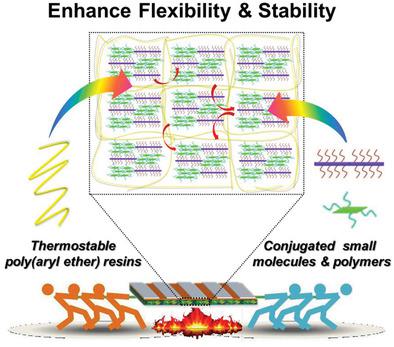当前位置:
X-MOL 学术
›
Adv. Funct. Mater.
›
论文详情
Our official English website, www.x-mol.net, welcomes your
feedback! (Note: you will need to create a separate account there.)
A Universal Method to Enhance Flexibility and Stability of Organic Solar Cells by Constructing Insulating Matrices in Active Layers
Advanced Functional Materials ( IF 18.5 ) Pub Date : 2020-07-16 , DOI: 10.1002/adfm.202003654 Jianhua Han 1 , Feng Bao 2 , Da Huang 3 , Xunchang Wang 1 , Chunming Yang 3 , Renqiang Yang 1 , Xigao Jian 2 , Jinyan Wang 2 , Xichang Bao 1 , Junhao Chu 4
Advanced Functional Materials ( IF 18.5 ) Pub Date : 2020-07-16 , DOI: 10.1002/adfm.202003654 Jianhua Han 1 , Feng Bao 2 , Da Huang 3 , Xunchang Wang 1 , Chunming Yang 3 , Renqiang Yang 1 , Xigao Jian 2 , Jinyan Wang 2 , Xichang Bao 1 , Junhao Chu 4
Affiliation

|
With the rapid development of power conversion efficiency (PCE), flexibility–stability of organic solar cells (OSCs) are becoming one of the primary barriers for commercialization. This work shows that insulating poly(aryl ether) (PAE) resins have highly twisted‐stiff backbones without any side chains, which possess excellent mechanical stability, thermal stability, and good compatibility with organic photovoltaic materials. After introducing 5 wt% PAE resin as supporting matrices into the bulk heterojunction (BHJ) layer, the device yields a high PCE of 16.13%. Importantly, the devices show impressive flexibility and improved stability with passivated morphology, such as PM6/Y6‐based devices with 30 wt% PAE retains the PCE of 15.17% and exhibits enhanced 4.4‐fold elongation at break (25.07%). This is the recorded stretchability of the BHJ layer for OSCs with PCE > 8%, and morphological changes during tensile deformation are first investigated by in situ wide‐angle X‐ray scattering measurements. The PAE matrices strategy exhibits good universality in the other four photovoltaic systems. These results demonstrate that heat‐resistant PAE resins serve as supporting matrices with a tunneling effect into OSCs without sacrificing photovoltaic performance and simultaneously improve the flexibility and stability of devices, which can play an important role in promoting the development of stable and wearable electronics.
中文翻译:

通过在有源层中构建绝缘矩阵来增强有机太阳能电池的灵活性和稳定性的通用方法
随着功率转换效率(PCE)的快速发展,有机太阳能电池(OSC)的灵活性-稳定性已成为商业化的主要障碍之一。这项工作表明,绝缘的聚(芳基醚)(PAE)树脂具有高度扭曲的刚性主链,没有任何侧链,具有出色的机械稳定性,热稳定性以及与有机光伏材料的良好相容性。将5 wt%PAE树脂作为支撑基质引入本体异质结(BHJ)层后,该器件的PCE高达16.13%。重要的是,这些器件在钝化形态下表现出令人印象深刻的灵活性和更高的稳定性,例如PAE含量为30 wt%的基于PM6 / Y6的器件保留了15.17%的PCE,并表现出增强的4.4倍断裂伸长率(25.07%)。这是PCE> 8%的OSC的BHJ层的可拉伸性,并且首先通过原位广角X射线散射测量研究了拉伸变形过程中的形貌变化。PAE矩阵策略在其他四个光伏系统中显示出良好的通用性。这些结果表明,耐热PAE树脂可作为支撑基质,并在不牺牲光伏性能的情况下在OSC中产生隧穿效应,同时可提高器件的柔韧性和稳定性,这在促进稳定和可穿戴电子产品的发展中可以发挥重要作用。PAE矩阵策略在其他四个光伏系统中显示出良好的通用性。这些结果表明,耐热PAE树脂可作为支撑基质,并在不牺牲光伏性能的情况下在OSC中产生隧穿效应,同时可提高器件的柔韧性和稳定性,这在促进稳定和可穿戴电子产品的发展中可以发挥重要作用。PAE矩阵策略在其他四个光伏系统中表现出良好的通用性。这些结果表明,耐热PAE树脂可作为支撑基质,并在不牺牲光伏性能的情况下在OSC中产生隧穿效应,同时可提高器件的柔韧性和稳定性,这在促进稳定和可穿戴电子产品的发展中可以发挥重要作用。
更新日期:2020-09-18
中文翻译:

通过在有源层中构建绝缘矩阵来增强有机太阳能电池的灵活性和稳定性的通用方法
随着功率转换效率(PCE)的快速发展,有机太阳能电池(OSC)的灵活性-稳定性已成为商业化的主要障碍之一。这项工作表明,绝缘的聚(芳基醚)(PAE)树脂具有高度扭曲的刚性主链,没有任何侧链,具有出色的机械稳定性,热稳定性以及与有机光伏材料的良好相容性。将5 wt%PAE树脂作为支撑基质引入本体异质结(BHJ)层后,该器件的PCE高达16.13%。重要的是,这些器件在钝化形态下表现出令人印象深刻的灵活性和更高的稳定性,例如PAE含量为30 wt%的基于PM6 / Y6的器件保留了15.17%的PCE,并表现出增强的4.4倍断裂伸长率(25.07%)。这是PCE> 8%的OSC的BHJ层的可拉伸性,并且首先通过原位广角X射线散射测量研究了拉伸变形过程中的形貌变化。PAE矩阵策略在其他四个光伏系统中显示出良好的通用性。这些结果表明,耐热PAE树脂可作为支撑基质,并在不牺牲光伏性能的情况下在OSC中产生隧穿效应,同时可提高器件的柔韧性和稳定性,这在促进稳定和可穿戴电子产品的发展中可以发挥重要作用。PAE矩阵策略在其他四个光伏系统中显示出良好的通用性。这些结果表明,耐热PAE树脂可作为支撑基质,并在不牺牲光伏性能的情况下在OSC中产生隧穿效应,同时可提高器件的柔韧性和稳定性,这在促进稳定和可穿戴电子产品的发展中可以发挥重要作用。PAE矩阵策略在其他四个光伏系统中表现出良好的通用性。这些结果表明,耐热PAE树脂可作为支撑基质,并在不牺牲光伏性能的情况下在OSC中产生隧穿效应,同时可提高器件的柔韧性和稳定性,这在促进稳定和可穿戴电子产品的发展中可以发挥重要作用。











































 京公网安备 11010802027423号
京公网安备 11010802027423号